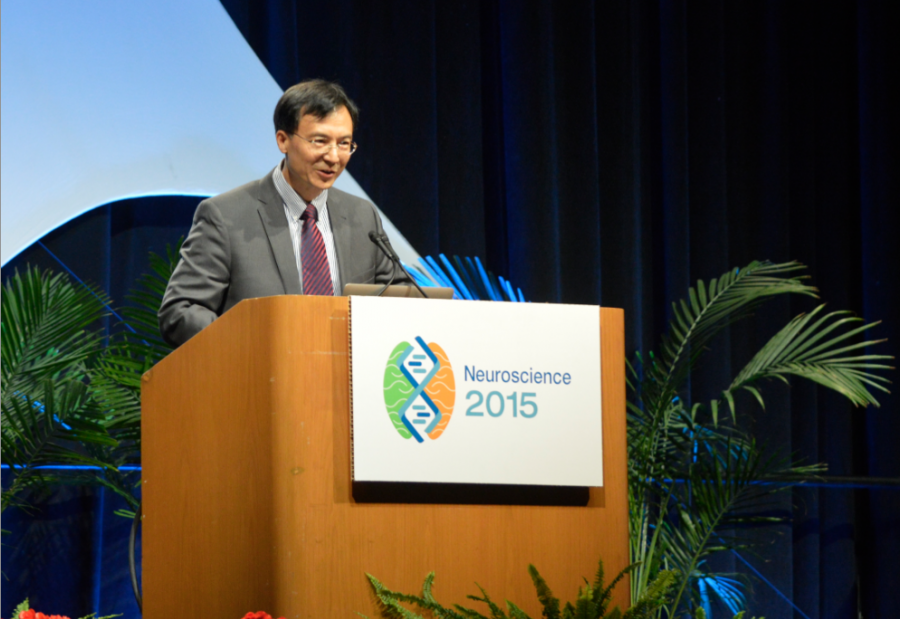Yan Dong’s research on illicit drugs’ movement through the brain has been a work in progress since 2006. Now, he is learning how to use that movement to reverse the negative effects of addiction.
Dong , an associate professor of neuroscience at Pitt and head of a neurosciene lab in Crawford Hall, conducts studies on drug addiction pathways in the brain, searching for a way to reverse relapse during recovery. Dong’s research focuses on three main points, development of neural circuits, cue induced cravings and reversing the effects of drug use on the brain. Dong said his own personal interest drives his work in motivated behavior and a concern for the effect of substance abuse in society. In early October, the Society for Neuroscience recognized Dong’s work on drugs and neurological pathways.
“I have always been very interested in motivated behavior,” Dong said. “And drugs are the best models to study this since they make you motivated to work for the drug, and nothing else. The mechanisms underlying such strong motivated behavior give us insight on how our brains regulate motivation.”
According to the National Institute on Drug Abuse, the prevalence of many drugs — including alcohol, cocaine, crack cocaine, marijuana and methamphetamine — has steadily increased from 2012 to 2014 in people ages 12 and older. Tobacco, alcohol and illicit drugs cost more than $700 billion annually in crime, lost work productivity and health care related costs.
Paul Phillips, an associate professor and researcher at the University of Washington who has worked with Dong in the past, also focuses on brain changes that occur with substance abuse. He said the severity of the substance abuse problem in the country is not just an issue that affects people who have addictions.
“To put [the financial cost of substance abuse] in perspective, it costs more than five times what the wars in Iraq and Afghanistan cost, around $120 billion annually,” Phillips said.
The Society for Neuroscience awarded Dong the Jacob P. Waletzky Award on Oct. 9 to honor his accomplishments in the area of substance abuse, the brain and the nervous system. The Jacob P. Waletzky Family Fund awards a $25,000 prize, established in honor of Waletzky, who died in 2001 of a cocaine-induced cardiac arrhythmia at the age of 29.
“This award is the culmination of almost a decade of work,” Dong said. “I started the first steps of the research— identifying the neural pathways involved in addiction— in 2006 and have been continuing ever since.”
Dong analayzed how motivation works in the brain using drug-addicted rat models that he taught to self-administer cocaine. He mapped out the neural pathways, which are sequences of neurons that fire signals, associated with addiction and prolonged use of drugs. He found that the brain’s major reward and motivation centers — the amygdala and nucleus accumbens — communicate differently as a result of drug use.
Dong also studied cue-induced relapse, which is a relapse following a stimulus associated with the drug. When the rats self-administered cocaine, a light would flash, serving as a stimulus. After recovery, exposure to this stimulus could induce relapse, and Dong found the nucleus accumbens — a structure in the brain responsible for processing rewarding stimuli — were responsible for cue-induced relapse.
Finally, deep brain stimulation, which electrically shocks specific areas in the brain to prevent them from firing, reversed the neural pathways that developed from drug exposure. In this case, Dong would shock the amygdala and the nucleus accumbens, which achieved some anti-relapse effects in rats.
In 2010, Phillips collaborated on a study with Dong to research the effect that behavioral adaptations from repeated drug use had on the type of pathway the drug used. He said Dong’s work is instrumental in the study of addiction and recovery.
“I’ve known Dong for a long time, and he is very respected in the research community,” Phillips said. “His integrity, and the robustness and direction of his research allow us to understand the brain further and provide help to addicts.”
Masago Ishikawa, an assistant professor of pharmacology and systems therapeutics, worked with Dong in 2013 on research about the effect of cocaine on the nucleus accumbens, a major reward center in the brain.
“We collaborated on the basis for his current work,” Ishikawa said. “We were working on addiction research, specifically cocaine addiction, and we developed a few specific neural pathways in cocaine addiction.”
For Dong, focusing on the combination of different aspects of addiction in terms of treatments, parts of the brain and types of addiction is the key to finding a cure.
“The best way to win a battle is to better understand your enemies,” Dong said.



